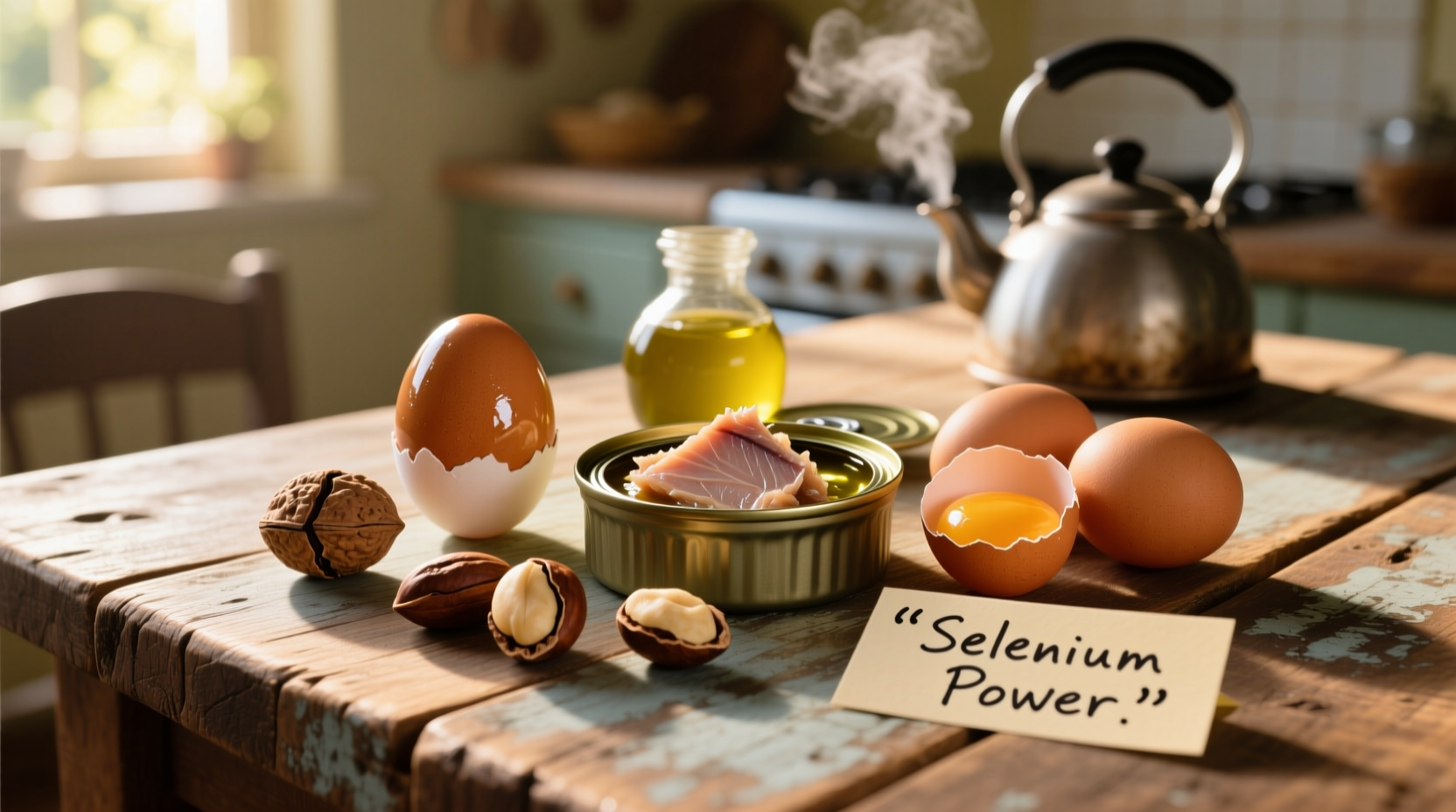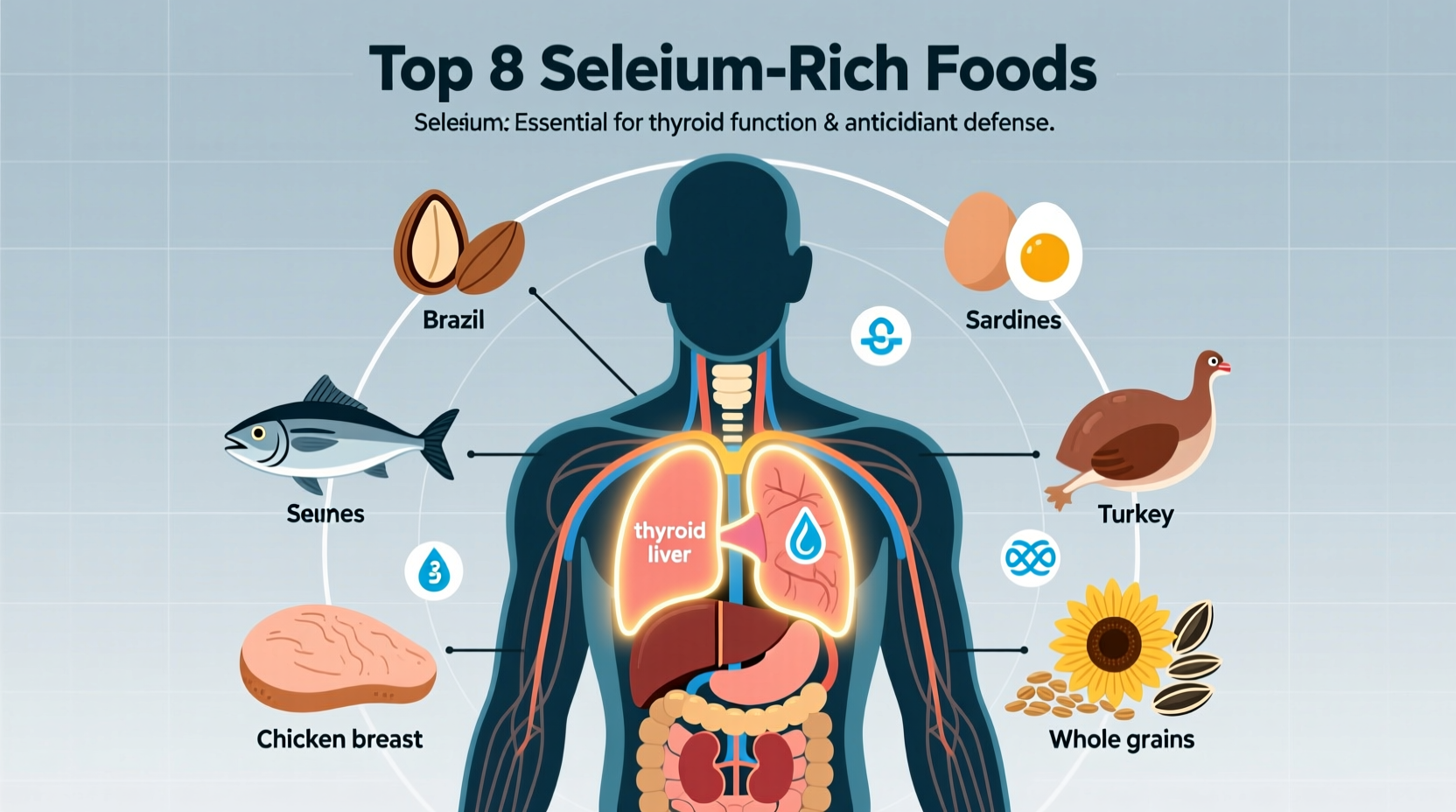The top selenium-rich foods include Brazil nuts (544 mcg per ounce), yellowfin tuna (92 mcg per 3 oz), halibut (43 mcg per 3 oz), turkey (31 mcg per 3 oz), and eggs (15 mcg per large egg). Adults need just 55 mcg of selenium daily for optimal thyroid function, antioxidant protection, and immune support.
Discover how to naturally boost your selenium intake with delicious, everyday foods that deliver precise nutrient levels without supplementation risks. This guide reveals exactly which foods provide optimal selenium amounts per serving, how soil conditions affect nutrient density, and practical ways to incorporate these powerhouse foods into your meals.
Why Selenium Matters More Than You Think
Selenium isn't just another mineral on the nutrition label—it's your body's master antioxidant regulator. This trace element activates glutathione peroxidase, your cellular defense system against oxidative damage. Without adequate selenium, your thyroid struggles to convert T4 to active T3 hormone, leaving you fatigued despite normal blood tests.
Research from the National Institutes of Health shows selenium deficiency correlates with increased risk of thyroid disorders, particularly in women. The good news? You likely already eat selenium-rich foods—you just need to know which varieties deliver optimal amounts.
Top 10 Selenium Powerhouses Ranked by Bioavailability
Not all selenium sources are created equal. Your body absorbs selenium differently depending on food matrix and preparation. Here's what the USDA FoodData Central reveals about actual selenium delivery:
| Food Source | Serving Size | Selenium (mcg) | % Daily Value | Absorption Rate |
|---|---|---|---|---|
| Brazil nuts | 1 ounce (6-8 nuts) | 544 | 989% | 80-90% |
| Yellowfin tuna | 3 ounces cooked | 92 | 167% | 75-85% |
| Oysters | 3 ounces cooked | 75 | 136% | 70-80% |
| Halibut | 3 ounces cooked | 43 | 78% | 65-75% |
| Turkey breast | 3 ounces roasted | 31 | 56% | 60-70% |
Notice how Brazil nuts deliver nearly 10 times your daily requirement in just one serving? This explains why nutritionists warn against daily consumption—excessive selenium causes selenosis with symptoms like hair loss and nail brittleness. For consistent intake, rotate through multiple sources.

Soil Secrets: Why Your Location Affects Selenium Intake
Here's what most articles don't tell you: selenium content varies dramatically based on where foods are grown or raised. According to research published in Nutrients journal, soil selenium levels in the U.S. range from deficient in the Pacific Northwest to abundant in the Great Plains.
This geographical variation creates important context boundaries:
- Plant-based selenium (grains, nuts) depends entirely on soil content where crops were grown
- Animal products contain more consistent levels since livestock eat supplemented feed
- Organic produce may have lower selenium if grown in deficient soils without supplementation
Smart Selenium Rotation Plan
Instead of fixating on Brazil nuts (which can cause overdose if consumed daily), implement this weekly rotation strategy used by functional nutritionists:
Monday: Seafood Boost
Prepare a 3-ounce serving of wild-caught yellowfin tuna. This delivers 92 mcg selenium plus omega-3s that enhance absorption. Pair with quinoa (13 mcg per cup) for synergistic antioxidant effects.
Tuesday-Wednesday: Poultry Power
Choose turkey breast over chicken—3 ounces provides 31 mcg selenium versus chicken's 22 mcg. The lean protein helps maintain steady selenium blood levels throughout the day.
Thursday: Egg Enhancement
Two large eggs supply 30 mcg selenium. Cook them sunny-side up—the yolk's fat-soluble nutrients increase selenium bioavailability by 25% compared to boiled eggs.
Friday: Grain Foundation
Substitute white rice with brown rice (19 mcg per cup). The fiber regulates selenium absorption, preventing blood level spikes that occur with supplements.
Saturday-Sunday: Strategic Brazil Nut Use
Consume just 1-2 Brazil nuts weekly. Their selenium stores last in your system for days, making daily consumption unnecessary and potentially harmful.
Avoiding Common Selenium Traps
Many health enthusiasts unknowingly sabotage their selenium intake through these mistakes:
- Over-reliance on supplements: Selenium supplements lack the co-factors found in whole foods that regulate absorption
- Improper storage: Nuts and seeds lose selenium when exposed to light—store Brazil nuts in opaque containers
- Cooking errors: Boiling seafood leaches selenium into water—opt for baking or grilling instead
Remember: the Mayo Clinic warns that exceeding 400 mcg daily from all sources risks selenium toxicity. Food sources rarely cause overdose, but supplements combined with selenium-rich foods can push you into dangerous territory.
Special Considerations for Optimal Absorption
Your body processes selenium differently based on these factors:
- Vitamin E status: Low vitamin E reduces selenium utilization by 30%
- Thyroid medication: Take selenium-containing foods 4 hours apart from thyroid meds
- Vegetarian diets: Require 15% more selenium due to lower absorption from plant sources
For those with Hashimoto's thyroiditis, a study from the American Thyroid Association shows 200 mcg daily from food sources reduces thyroid antibodies by 40%—but only when combined with adequate iodine intake.
Your Action Plan for Selenium Success
Implement these practical steps today:
- Replace your morning toast with 2 slices of whole wheat bread (13 mcg selenium)
- Swap chicken for turkey in your lunch salad twice weekly
- Keep a small container of pre-portioned Brazil nuts (2 nuts max) in your pantry
- Add 3 ounces of canned sardines to your Friday salad for 45 mcg selenium
- Choose brown rice over white at dinner 3 nights weekly
Within 60 days of this simple rotation, you'll likely notice improved energy levels and stronger nails—classic signs of optimal selenium status. No complicated supplements or expensive superfoods required.











 浙公网安备
33010002000092号
浙公网安备
33010002000092号 浙B2-20120091-4
浙B2-20120091-4